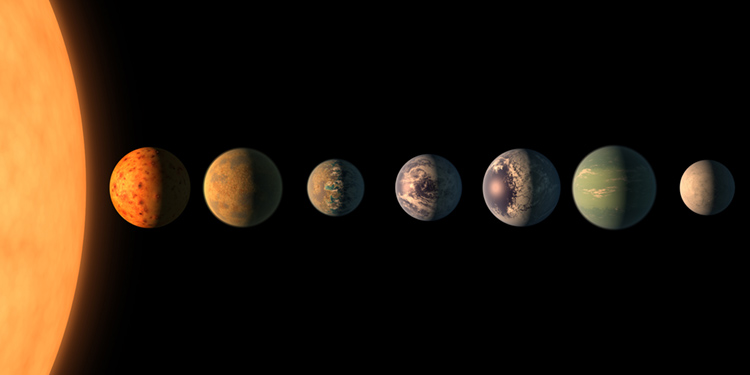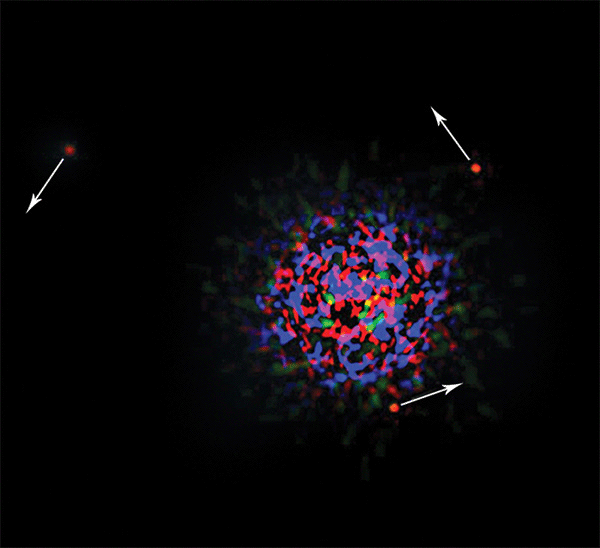Pocket Solar System May Be Right for Life
Wednesday, March 1st, 2017March 1, 2017
On February 22, astronomers announced the discovery of a remarkable planetary system orbiting a relatively nearby star. Planets outside the solar system are called extrasolar planets or exoplanets. The new system has a whopping seven planets, many of which might host conditions favorable for life. The finding was published in the journal Nature.

This artist’s concept shows what each of the TRAPPIST-1 planets may look like, based on available data about their sizes, masses and orbital distances.
Credit: NASA/JPL-Caltech
The system is located some 40 light-years away in the constellation Aquarius, the Water Bearer. One light-year is the distance that light travels in a vacuum in a year, about 5.88 trillion miles (9.46 trillion kilometers). The planets orbit a star called TRAPPIST-1, named in honor of the telescope used in the discovery. TRAPPIST stands for Transiting Planets and Planetesimals Small Telescope. It is a robotic telescope in Chile funded by Belgium. In May 2016, TRAPPIST detected three planets orbiting a type of small, relatively cool star called a red dwarf. In September, the Spitzer Space Telescope, operated by the United States National Aeronautics and Space Administration (NASA), began monitoring the system. With the help of NASA’s Hubble Space Telescope and other ground-based telescope systems, Spitzer confirmed the existence of two of the planets. But Spitzer determined that the third signal detected by TRAPPIST actually came from four planets, not one. Later, the telescope observed traces of a seventh, even more distant, exoplanet.
Even this farthest exoplanet orbits closer to TRAPPIST-1 than Mercury does to the sun, at a distance of only about 5.6 million miles (9.0 million kilometers). For comparison, Earth orbits about 93 million miles (150 million kilometers) from the sun. Because red dwarfs are much smaller and cooler than the sun, however, three of the planets orbit within a region that should be neither too hot nor too cold for liquid water to exist on their surfaces. Most scientists consider liquid water essential for life, so such a region around a star is known as its habitable zone.
The planetary system’s compact size would provide spectacular views only imagined in science fiction. The star TRAPPIST-1 would appear three times as large as the sun does on Earth, bathing the planets with a dim, pinkish light. Because the exoplanets are so close together, an observer standing on one planet could clearly see the other six. Neighboring planets would sometimes appear larger than does the moon in Earth’s sky.
Follow-up studies are already underway. NASA’s renowned planet-hunting satellite Kepler is currently examining the system. All seven planets are about the size of Earth, but Kepler will more precisely calculate their sizes and possibly find more planets. Spitzer has already confirmed that two of the planets are rocky worlds, rather than gaseous planets like Neptune. But Spitzer will continue to examine the system to learn more about the planets’ masses and compositions. In 2018, NASA plans to launch the James Webb Space Telescope. This powerful satellite should be able to detect if any of the exoplanets have atmospheres and determine their compositions. If the atmosphere contains compounds such as methane, oxygen, and ozone, it would be a strong indication that life exists there.
Other Behind the Headlines posts:
- Ten to 30 Alien Planets for Every Person on Earth? (Jan. 13, 2012)
- Amateur Astronomers Discover a Planet with Four Suns (Oct. 17, 2012)
- New Exoplanet Candidates from Ailing Kepler Spacecraft (June 20, 2013)
- Kepler Space Telescope Goes Dark–For Now (Aug. 16, 2013)
- Exoplanet Bonanza from Kepler (Feb. 27, 2014)
- First “Earth-Cousin” Found by Kepler Space Telescope (May 1, 2014)
- “Hello, Aliens? Are You Out There?” (Feb. 13, 2015)
- New Planetary Neighbors (May 11, 2016)
- The Pale Red Dot: Proxima b (Aug. 31, 2016)




